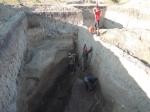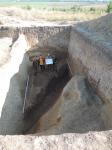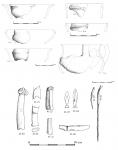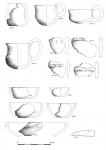Summary (English)
During the season of 2015, the expedition worked on two areas of the hillfort.
First, it is the North-Western excavation site where three pits (№№ 31-33) were explored over the eroded slope. Not so many artefacts were found within those objects, mostly small shreds of the local pottery. Instead, an interesting set of archaic ladles with slightly incurved profiles were discovered in the cultural layer. Also, a rare flint sickle was deposited together with the ladles.
The main attention was paid to the Central excavation site where exploration of the huge complex continued. The total explored area reached 150 m2, but still, the researchers didn’t explore the whole central multi-layered complex. However, all the stratigraphic observations proposed in the previous year were testified.
Additionally, a bright set of artefacts was also collected here. Pieces of the other three psalia one of which was decorated with the head of the so-called griphin-ram is among them. A unique find is an iron socketed axe. It was detected on one of the fireplaces that are stressed its unusual character. Interesting, analogies for such kinds of tools are found in Central Europe. Other metal objects are typical for the local Scythian culture. It is such finds as trilobate arrowheads and iron pins. Besides the material objects, a lot of animal bones were collected while exploring the coaly layers. Most of them belong to the cattle and the bones of the wild animal are single. Especially interesting is the chopped jaw of a young woman that was found among the animal bones.
Summing up, though the central multi-layered complex was not fully excavated, it could be considered as an extraordinary structure. Perhaps, it was a religious building for communal feasts and gatherings.
Finally, several finds of the flint tools could be seen among the Scythian materials. But perhaps those artefacts were redeposited while constructing this complex in the Early Iron Age.
- Shelekhan Oleksandr - Institute of Archaeology, National Academy of Sciences of Ukraine
Director
- Marcin Ignaczak - Adam Mickiewicz University in Poznan
- Yuriy Boltryk - Institute of Archaeology, National Academy of Sciences of Ukraine
Team
- Oksana Lifantii - National University of Kyiv-Mohyla Academy
- Shelekhan Oleksandr - Institute of Archaeology, National Academy of Sciences of Ukraine
- Mykhailo Kublii - Institute of Archaeology, National Academy of Sciences of Ukraine
- Yevheniia Yanish - I. I. Schmalhausen Institute of Zoology, National Academy of Sciences of Ukraine
Research Body
- Institute of Archaeology, National Academy of Sciences of Ukraine
- Instytut Prahistorii Uniwersytet im. Adama Mickiewicza w Poznaniu
Funding Body
- National Science Centre (Narodowe Centrum Nauki)





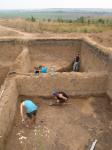
![Download [PDF]](/excavation/skins/fasti/images/results/download_sml.png)
